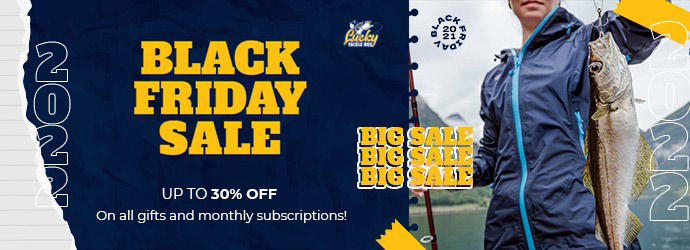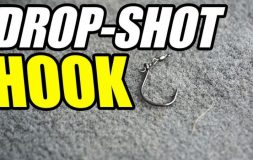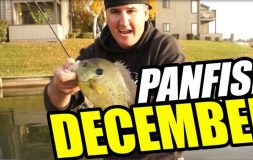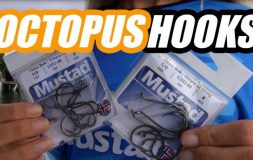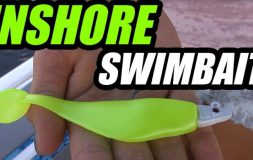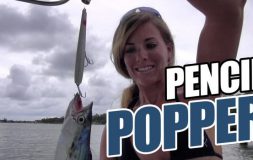Living room 2 lake with Travis Moran – September edition!
You asked, we answered! Monthly unboxing videos are BACK with Travis Moran, our Chief Fishing Officer. To kick things off, Travis released the September edition of “Living Room 2 Lake” on Saturday, October 12.
“Living Room 2 Lake” will be a monthly video series that features Travis unboxing his latest Lucky Tackle Box and explaining how, when, and why to use the specific baits, lures, and tackle inside. Then, he’ll take us out on the lake to showcase his new fishing gear in action – both above and BELOW the water!
“Living Room 2 Lake is all about building a full Lucky Tackle Box experience. We’re going to go through each box’s baits so subscribers can understand where to throw them and how to rig them so they can have more confidence on the water!” – Travis Moran
Hell yes, Travis! Let’s catch some fish!
Here are the top 3 lessons from the September “Living Room 2 Lake” video:
- How To Transition To Fall Fishing
It’s officially fall, y’all! The days are getting cooler, the nights are getting colder, and water temperatures are dropping hour by hour. The changing season is triggering fish – particularly bait fish – to school up and head into coves, marinas, and big creek channels. And – of course – where the bait fish go, bass will always follow. To identify these productive fishing areas, Travis recommends looking out for birds and healthy signs of life, because that’s likely where the fish will be.
- Topwater Baits Are Great For Shore Fishing
Topwater baits are a popular choice for anglers who fish from the shore because they can see the bait working and anticipate the bites. When fish finally strike, they erupt from the water to attack – talk about an adrenaline rush! If you’re fishing from the shore with topwater baits, you should cast your lure out as far as possible, either along the tree line or over trees that are just submerged. Then, put the rod tip down and make little jerks so those topwater baits POP!
- Don’t Be Afraid Of Big Hooks
Many baits and lures come already equipped with light wire hooks, which can work great by themselves! However, anglers shouldn’t be intimidated by meaty-looking hooks, especially under the right fishing conditions. For example, if you’re fishing around thick cover, big bass are going to come out of hiding and hit your lure with full force, then quickly retreat. Those big fish will put up a fight and bend light wire hooks, and you might lose the best catch of your life! Oh, and don’t forget to switch out your hooks at least once or twice each season.
Watch the full “Living Room 2 Lake” video or read the transcription below.
Tight lines, angler – we’ll see ya back here next month!
“Living Room 2 Lake” September/October Video Transcription:
What is up everyone? Travis Moran here and I couldn’t be more excited to be back with the new Lucky Tackle Box management. You are tuned into our new style of videos, Living Room 2 Lake series, where I head out on the water, which I’ve already done. This is the September box that we’re going to be talking about today, which all of you guys should have sitting right next to you so you can follow along.
I went out on the water, shot footage, even put scuba gear on, got in the water so I could get you guys underwater footage. Then came back home to my living room, sitting down with you guys, the subscribers, and we’re going to open up this box and go through every one of these baits that you received last month, so that you can better understand where to throw them, how to rig them, so you can have more confidence in going out to your local water and catching more fish!
Lucky Tackle Box is all about building the experience and this is a great way for us to do that, to communicate with you guys, and get you guys a little more confident in the baits that you are getting. If you like this concept, if you have suggestions, any comments, make sure you do so below in the comment section.
Now before we dive into this box, I want to make a quick announcement on the October boxes. As the management shifted over, obviously you guys realize that Lucky Tackle Box went through a huge change. Well part of that change is they are changing up the baits they order. They want to step up the quality. You guys are going to be very excited to see how the future progresses with Lucky Tackle Box, but part of doing that means we are going to have some delays in getting the lures in and other things like that.
So, you’re still going to get your box in October. It’s just being delayed a little bit and then the other reason is, the magazine got cut out with the new management. It didn’t make the shuffle over and you guys demanded it back. We had so much feedback, so many requests to have it back, so we hired a brand new team to create the magazine every month and that will also be in the October box this month.
So even though it’s going to be delayed a little bit, it will be worth the wait and I cannot wait to do a Living Room 2 Lake series with that box that is going to be out before you know it.
All right, so let’s talk about the box. This is the September box. It’s October right now. It’s fall fishing. What are fish doing in the fall? Let’s first talk about the temperatures. We’re coming out of the summer. It was really hot. Things are starting to cool down. The nights are starting to get real cold and that’s bringing those water temperatures down and that’s triggering those fish and more importantly, the bait fish, into their fall modes.
What happens is, the shad, the different bait fish school up, head into coves, big creek channels, into marinas, and they can be easy pickings for hungry bass. So, because a lot of that food is concentrated in small areas, a lot of the bass are concentrated in those areas as well.
This time of the year, you might go through long stretches without catching fish, but when you do find those fish, there’s a lot in that area. So really, it’s about identifying productive areas, whether it’s using a lure, you can cover a lot of water quickly until you find those areas or it’s being able to read the water really well. Looking for birds, looking for healthy signs of life in those areas. And that’s usually going to be where those bass are.
All right. The first bait we are pulling out of here is Down Home Lures, Uncle Popper. This is a top water style bait. I’ve already got one out of the package here. A top water style bait is probably one of the most popular baits for anglers who are just starting out in bass fishing. And there’s a couple reasons why.
First of all, it’s a top water lure. When you’re fishing on a top, it’s exciting. You can see this bait working and you can really anticipate the bites and then when the fish do strike it, they come launching out of the water. It erupts, the water’s going everywhere. It is pure adrenaline excitement at its best. Then the other reason is this is a smaller profile bait so you can throw it on lighter tackle, specifically spinning rods, which most anglers start off bass fishing using spinning rods.
This is a great bait for beginner fishermen to really master, but then it’s something that you will carry throughout your fishing career. So, it’s a great technique to learn. Also, a great technique to do from the shore, which I know a lot of you guys are always looking for more shore techniques that you can do.
What you do with this as you cast it out as far as you can, you can cast it out on the outside of tree lines or you cast it over trees that are just submerged under the surface there. And what this does is, you put that rod tip down, you make small little jerks with the rod. And what that’s going to do is going to make this bait pop. It’s got a little cup nose like that and that spits water. Every time you pop that bait, it spits water and it sounds like some little fleeing bait fish on the surface.
It will pull those fish out of the cover and they’ll come whack this. I like to give it a couple of jerks and let it sit for a second or two. A couple more jerks, let it sit for a second. And usually when it’s sitting, that’s when those fish are going to come hammer it. Now I’ll use anywhere from an eight to 10 pound mono or a 30 pound braid. The reason I want mono or braid is because both of those float.
You can use a fluorocarbon, but the problem is when you use a line that actually sinks, what’ll happen is that line will sink down into the water and when you go to jerk it, it’ll actually pull the bait down underwater instead of pulling it along the surface so it’s kicking up water. Great little bait. Can’t wait to hear how you guys are catching fish with it.
All right, for the next bait in here we have, here we go, Krave Baitz, The Digger. This is a medium diving crank bait. Let’s talk about crank baits really quick. The lip on a crank bait decides how deep this bait dives, and the action of the bait. So, as you retrieve this thing, you’re pulling on the bait, that lip is going to make this bait dive down to the depth that it is designed to do.
For this particular bait, that’s about five to eight feet deep, depending on what line you use. Now a crank bait, the best way to use a crank bait is to get that bait all the way down to the bottom. And as it’s banging along the bottom, as you’re reeling it in, it is deflecting off of rocks and different stuff down there, creating an erratic action that these fish love. It looks like some little bait fish scurrying around trying to get away or some little crawdad jumping around down there, and the bass will be triggered into striking.
This is the same size and profile as a lot of the bait fish this time of the year. Now we talked about fall, how these fish school up. This is a great bait to be able to cast as you go down the bank and you’re able to work an area quickly, to either find the fish or say, “Okay, I didn’t get bit. There’s probably no fish here. Let’s keep going until we find a productive spot.”
Now I mentioned this bait dives depending on the line that you’re using. Now I use anywhere from eight to 12 pound mono or fluorocarbon if I’m fishing from a boat. Whether that’s a kayak, pond boat, bass boat, but if I’m fishing from the shore, I’ll actually go to a little bit heavier line, like a 15, maybe a 17 pound mono or fluorocarbon.
And the reason I do that is because if I snag up, you’re more likely to snag up as you’re bringing this thing uphill towards the shore. And when you do, if you have some heavier lines, sometimes it’s easier to pull that free and get that snag out without losing this lure.
Now you do have an advantage though. When you are fishing from the shore, you are bringing it uphill, so you’re more likely to keep contact with the bottom. So, this can be a very effective tool, especially around some steeper banks. I know that my favorite time to throw a crank bait is early morning and late evening, and then if there’s any kind of breeze during the day.
If you have a bank where you’ve got a lot of wind going up against it, the fish will come up shallow because it actually pushes a lot of plankton, algae, all that stuff into those banks. The things that shad feed on move up to those banks, and the bass see a fantastic opportunity for an easy meal. If you throw this crank bait in there, you’re going to get bit, you’re going to fool them into biting this and catch a quick fish.
All right, our next bait in here is Rippn-Lips, The Wobbler. This is a small wake bait. I like this for two different applications. First of all, you guys like fishing small bodies of water, your local pond, anything like that? First thing in the morning or last thing in the evening, you cast this thing out there. You want to use it, similar line that we talked about with that popper.
You want a floating line whether it’s mono or my favorite, I like a braided line, like a 30 pound braided line. Cast it out, you can use this on a spinning rod, as well. Cast it out, keep that rod tip up, slowly reel it. What this is going to do is, it’s actually not going to dive down underneath the water. It’s going to slowly wobble along the surface, creating a little wake. That’s where it gets its namesake, a wake bait. And it’s going to make that little wake and this keys fish in, especially with calm conditions.
You know there’s fish in that area somewhere. They’re going to hone into that little wake. It looks like something’s scurrying along the surface and they will come up and nail this great little bait. We talked about the lips of crank baits like this. This one’s actually not to make it dive, it’s a very small lip here. That’s just to give it a nice wobbling action. So that wake will draw those fish into the bait and then that wobbling action will make it look like something very real to them and they will eat it.
Now I mentioned there’s another application I really liked this for. This time of the year, fish chase shad, and you find those productive areas. A lot of times you’ll find what I call cheeseburger bass. That means you could throw a cheeseburger at them and they will eat it, they are ready to pounce on anything. But sometimes, especially when you’re in fishing areas that get heavily pressured with a lot of fishermen in there, and the bait fish are really small, the bass are not going to eat some of the bigger baits.
They start getting picky and they really just want baits that look a lot like the ones they’re actually chasing. So if you’re throwing bigger top water baits and these big feeding fish are not hitting that, downsizing to a smaller profile bait like this, which matches the size of the actual bait that they’re chasing, can be the difference to you getting those fish to actually fully commit to your bait.
All right, up next in the box is Phenome Lures, The Prick. There were different colors sent out to our subscribers. Some of you guys got some more vibrant colors, some of you got some more natural looking. These more vibrant colors excel in dingier water or low light conditions, like first thing in the morning or later in the evening. They really show up better and give the fish something to see. These more natural looking colors excel during calm, clear water situations.
So, depending on where you’re fishing, different colors matter a whole lot. I definitely recommend that you experiment with those. Now, finesse baits work year-round. There’s never a bad time to fish. Sometimes fish are active and wanting to chase things down, but they’ll still eat an easy meal as well. And so really mastering your finesse game is very important.
Because even when you do find active fish and you’re catching them on, say one of the crank baits or the top water baits, once that slows down, once you’ve caught those real active fish, there’s still fish in the area. You didn’t catch them all, they’ve just wised up or they’re just not being as active. That feeding window is over. So that’s a perfect time to slow down with something like this, the Prick here.
And I rig it up on a drop shot rig. I love throwing these types of baits on a drop shot. It’s a size two, little drop shot hook, Mustad drop shot hook with a 3/16th to a quarter ounce drop shot weight. And you tie that up with a Palomar knot. You just leave about six to 12 inches of tagline where you put your weight and that really gives that bait a natural look. You can shake it, makes it look real lifelike and then when you give it slack, it’ll flutter down to the bottom like some kind of dying bait fish.
And the fish and love that. A lot of times when you have fish feeding on the surface, there are fish down at the bottom. The bigger, smarter fish are down at the bottom waiting for those dying, wounded bait fish as they fall down. Those are very easy. They don’t have to exert the energy chasing them around.
So, you guys fishing a drop shot can work from the shore. It’s just a technique that works nonstop. Once again, you can also put this worm on a Shaky Head or a Texas rig, whatever your favorite type of fishing of finesse baits is, this bait is going to excel at that.
Next up, we have some treble hooks. These are Mustad KVD Round Bend Trebles, size one. These are some meaty looking hooks. I don’t want you to be intimidated by these. These are great replacements. You should always have fresh treble hooks ready to go. On your favorite baits, you should be changing them out once or twice a season and then changing them out depending on the conditions you fish.
So, for these size hooks, this is on some of your bigger baits, like your River2Sea S-Waver or the River2Sea Whopper Plopper, great hooks to replace. But then also, some baits that don’t always have some bigger hooks like this, like your Zara Spook here.
What I like to do is, these come with some real light wire hooks, which can work fantastic for most of the time. But I like fishing these around some thick cover, thick structure. I have a fly literally landing on my eyelash right now. All right. And so, when I’m fishing around any kind of covered structures, these big bass are going to come out, hit this thing and then want to go back. I can’t let them do that.
And if I have light wire hooks, those big fish are going to bend those hooks out. So, I’ve got to beef up this bait a whole lot. And so, what I do is, I put bigger hooks on the two end rings here and I actually will remove the middle one. So, there’s actually, normally there’s three hooks on it. I’ll just have two big hooks on either end. When that fish comes up, eats it, gets hooked, I can really cinch down that drag and not let that fish go back in there. I’m not worried about losing that fish as much.
All right, so you guys following at home, if you have the regular box subscription, you had all the baits that I just talked about. Same thing with you XL subscribers. But now the next two baits in the box were just available to the XL people. So, the first one is the Wavelength Wave Walker.
If you’re fishing in the fall, you need to have a walking style bait like this. The reason being is, there’s so much bait fish and shad that these bass are feeding on, that you’ve got to have something that imitates that very well. Now these fish, the bass will school or will chase these schools around and as the school finally gets to the surface, that’s the best opportunity for the bass because they pin them against the surface.
That’s where you’re seeing the little bait fish try to jump out of the water and you’re seeing bass just come explode after them. And easiest way to see this is looking on the horizon, seeing birds diving down like seagulls and things. Because the seagulls will hover, and they’ll see the little bait fish scurrying along the top and they’ll come pick off that. And that’s a great way to know there’s active bass in the area.
Then you have a walking bait like this, so you throw it out there. This is a top water bait, throw it out and you make little twitches. And this bait will work side to side as you’re twitching it, which is called walking the dog. And it looks like fleeing fish on top of the water and these bass cannot resist it. The other thing is it’s a nice thin, heavier weighted lure so you can cast it a long distance.
I like to rig it up on 30 pound line with about a seven foot, moderate action rod and you can just go to town. Guys, this is so much fun. One of the ways, a couple of ways to find active areas. You want to look for birds, even if the birds aren’t actively feeding, if they are in an area, that means at one point they were probably feeding in there. So that’s, and they’re just resting up or waiting for the next feeding frenzy.
And another thing to do is travel around. Even Leo’s like, look Leo’s like, “Dude, Trav, let’s go fish.” He heard me talking about fishing, he wants to come talk. This is Leo, my golden retriever. He’s enjoying Living Room 2 Lake series as well.
But guys, another key to finding productive areas is, these fish that are hitting top water lures or hitting, exploding on the top, do that first thing in the morning and last thing in the evening. So, you really want to be there, moving around different coves and stuff during these high percentage areas and you’ll see active fish, and that’s where you want to spend your time in.
Know that that’s when these fish are going to expose themselves. You’re going to know these are active areas. Then through the afternoon, they might not be feeding on top water lures, but that’s where you circle back around with some of these finesse baits. Some of the, like a crank bait that you can get deeper down there and find those fish that aren’t as actively feeding at that moment.
Okay. Now the final bait in the box, Locals, The Commissioner. This is a smaller style crank bait, very good for fishing from the shore or those smaller bodies of water, as well as fishing from a boat. You can use it on the spinning rods. This is going to be a favorite of a lot of beginner anglers. And then once again, we have the smaller lip. This one is a little bit wider, so it’s actually going to get this bait to dive a little bit subsurface, where if you remember, the smaller wake bait did not have as wide a lip.
This is going to create that bait to dive six to eight inches underneath the water. Not very deep, just barely subsurface. Looks like a little frog style bait down there swimming along. This time of the year in the fall, during the summer, actually let’s back up. During the summer, we get a lot of grass growth. It’ll grow all the way up to the surface, really swamp out little bodies of water or corners of lakes and stuff, and this is where frogs and things like that can excel.
But then as the temperatures cool down and we get those real cold nights, it’s going to kill that grass, a lot of that grass down a little bit. So, the grass will actually start dying off, so it’ll be about a foot below the surface this time of the year. And that’s why a little shallow diving bait like this can be perfect because you’re going to be just above and just along that top of that grass, where that’s where a lot of the bait fish hang out. That’s where they’re going to be scurrying along.
Bass are waiting in that grass to see something scurry along there and they will hit that. So, all you do is just cast this thing out. Just have a nice slow retrieve and that’ll dive down there. It’s got smaller treble hooks, and as these hooks, if they catch up in any of that grass, just give it a little twitch and that’ll break it free. And also, it will trigger strikes. When you pop that free from grass, that can be the best way of enticing bass to react.
All right guys, that’s everything for the September Lucky Tackle Box. Hopefully you enjoyed this new Living Room 2 Lake series. I know Leo here did. He is pumped. He’s like, “Travis, you sold me. Those lures are fantastic. I understand how we’re going to catch fish on them. Now let’s go out fishing.”
Any of you guys that have seen a lot of my videos that are on the Lucky Tackle Box YouTube channel, you will recognize this guy. He is my camera man, my wingman. He is my partner on the videos. But anyway, if you like this style of video, you guys let me know. Let me know what lures you’re most excited about.
And then also when you’re out fishing these baits, take pictures and tag us on Instagram, Facebook, or whatever social media channels you’re using. Once again, I’m Travis Moran, happy to be back with the new Lucky Tackle Box and we hope you guys are happy about the new things that we’re doing here in bringing this company back. Appreciate your support and we will catch you out on the water!


